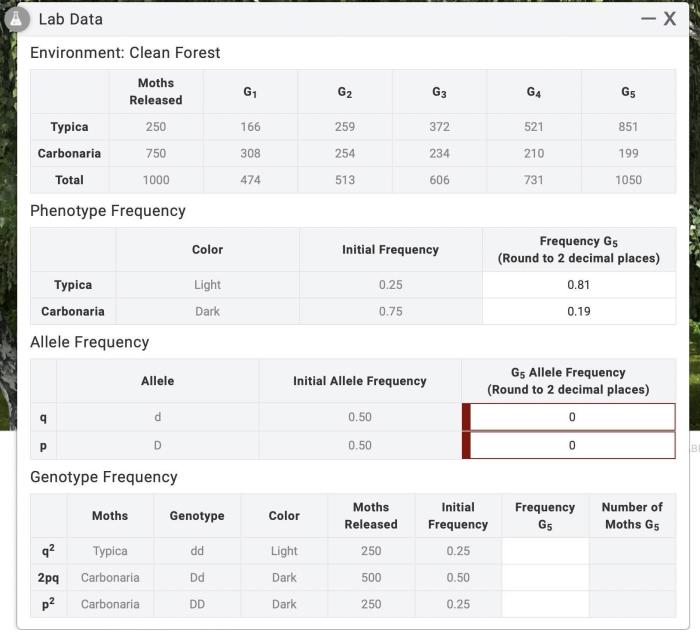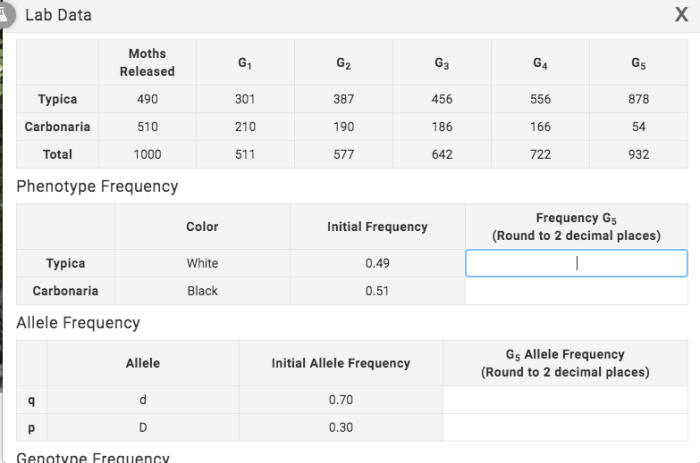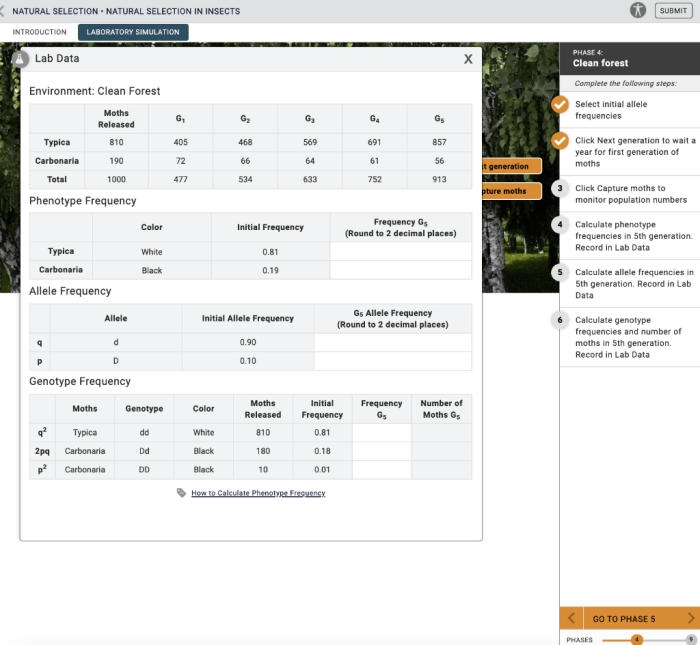Calculate allele frequencies in 5th generation. record in lab data – Calculating allele frequencies in the 5th generation is a crucial aspect of genetic analysis, providing valuable insights into the genetic makeup of a population. This comprehensive guide will delve into the concept of allele frequencies, the methods used to calculate them, and the factors that can influence their changes over generations.
Additionally, it will present a structured approach to recording and analyzing allele frequency data, enabling researchers to effectively capture and interpret genetic information.
The significance of allele frequencies lies in their ability to reveal patterns of genetic variation within a population. By understanding the distribution of different alleles, researchers can gain insights into the evolutionary forces shaping the population, such as natural selection, genetic drift, and mutation.
This knowledge is essential for comprehending the genetic basis of traits, predicting the likelihood of inherited diseases, and developing strategies for genetic conservation.
Allele Frequency Calculation in the 5th Generation: Calculate Allele Frequencies In 5th Generation. Record In Lab Data

Allele frequencies are crucial parameters in genetic analysis, reflecting the proportion of different alleles present within a population. These frequencies provide insights into the genetic diversity and evolutionary dynamics of a population. In this article, we will delve into the concept of allele frequencies and the methods used to calculate them, particularly in the context of the 5th generation.
Methods for Calculating Allele Frequencies, Calculate allele frequencies in 5th generation. record in lab data
Calculating allele frequencies involves determining the proportion of each allele relative to the total number of alleles in a population. The most straightforward method is the direct counting method, where the number of individuals carrying each allele is counted and divided by the total number of individuals in the population.
Another method, the Hardy-Weinberg equation, provides a theoretical framework for calculating allele frequencies under specific assumptions. This equation considers the frequencies of alleles in a population that is not undergoing evolution, assuming random mating and no other evolutionary forces. By comparing observed allele frequencies with those predicted by the Hardy-Weinberg equation, researchers can assess whether the population is evolving or not.
Factors Affecting Allele Frequencies
Allele frequencies are not static and can change over generations due to various factors, including:
- Natural selection:Alleles that confer an advantage in survival or reproduction become more frequent in a population over time.
- Genetic drift:Random fluctuations in allele frequencies can occur due to chance events, especially in small populations.
- Mutation:New alleles can arise through mutations, introducing genetic variation into the population.
- Gene flow:The exchange of genetic material between populations can alter allele frequencies.
Data Recording and Analysis
| Allele Type | Observed Number | Expected Number | Allele Frequency |
|---|---|---|---|
| A | |||
| a |
To record allele frequency data for the 5th generation, a table can be designed with columns for allele type, observed number, expected number, and allele frequency. This table allows for easy entry and organization of the data.
Discussion of Results
Once the allele frequency data for the 5th generation has been collected and analyzed, it is important to identify any trends or patterns. These patterns can provide insights into the genetic makeup of the population and the evolutionary forces that have shaped it.
For instance, if a particular allele shows a consistently high frequency across multiple generations, it may indicate that it confers a selective advantage or is linked to another advantageous allele. Conversely, if an allele shows a declining frequency, it may suggest that it is being selected against or is linked to a deleterious allele.
Understanding allele frequencies is essential for population genetics and provides a foundation for studying the genetic diversity and evolution of species.
Clarifying Questions
What is the significance of calculating allele frequencies?
Allele frequencies provide insights into genetic variation, evolutionary forces, and the genetic basis of traits, enabling researchers to understand population genetics and predict inherited diseases.
How can allele frequencies change over generations?
Allele frequencies can change due to natural selection, genetic drift, and mutation, resulting in the evolution of populations and the emergence of new genetic variants.
What methods are used to calculate allele frequencies?
Common methods include direct counting, Hardy-Weinberg equilibrium, and maximum likelihood estimation, each with its own advantages and applications.

